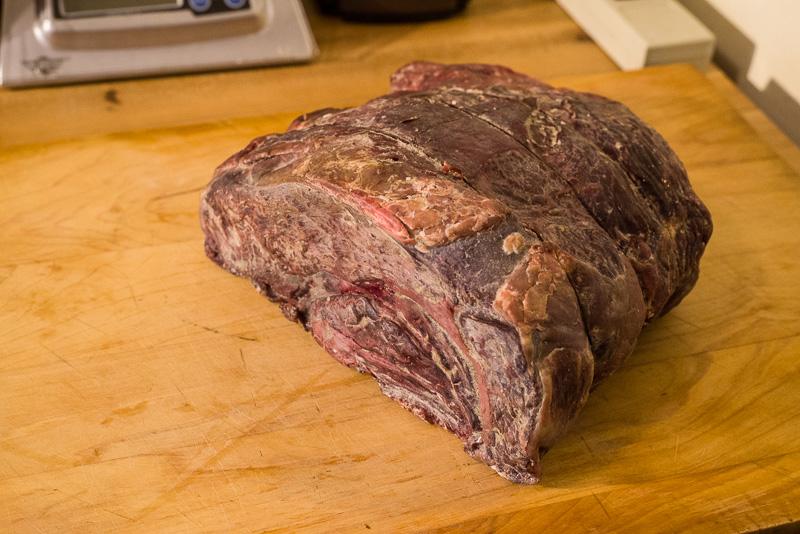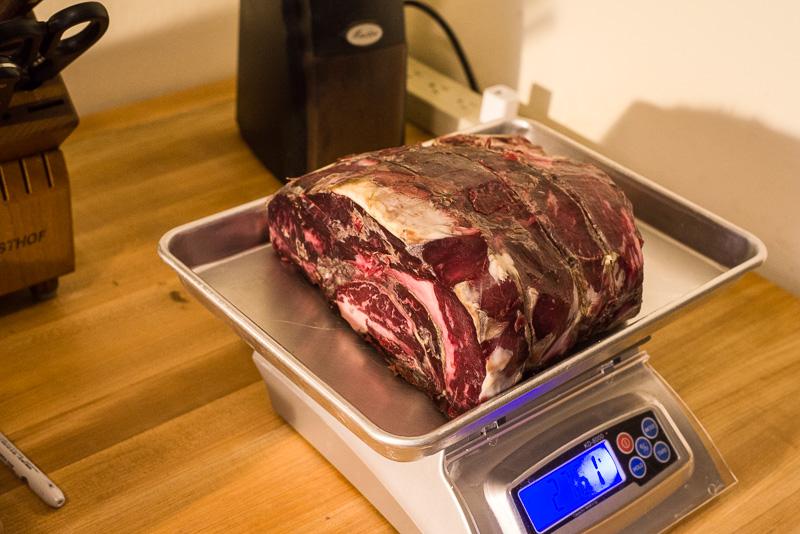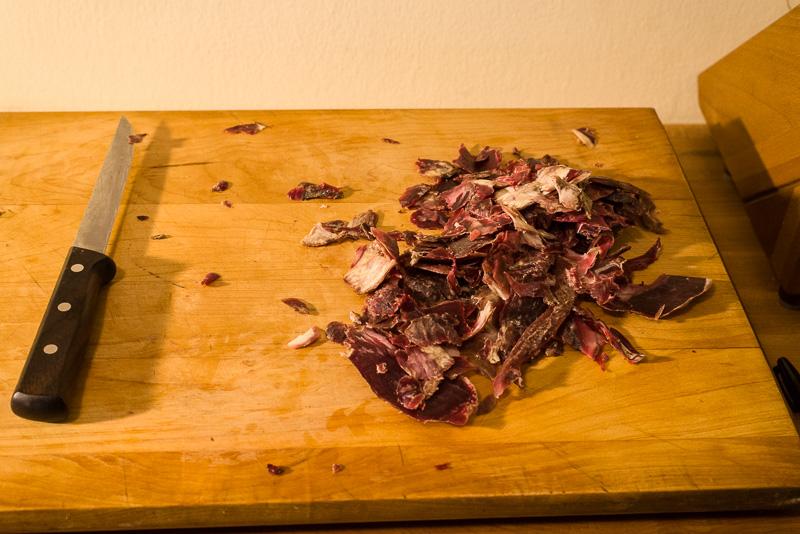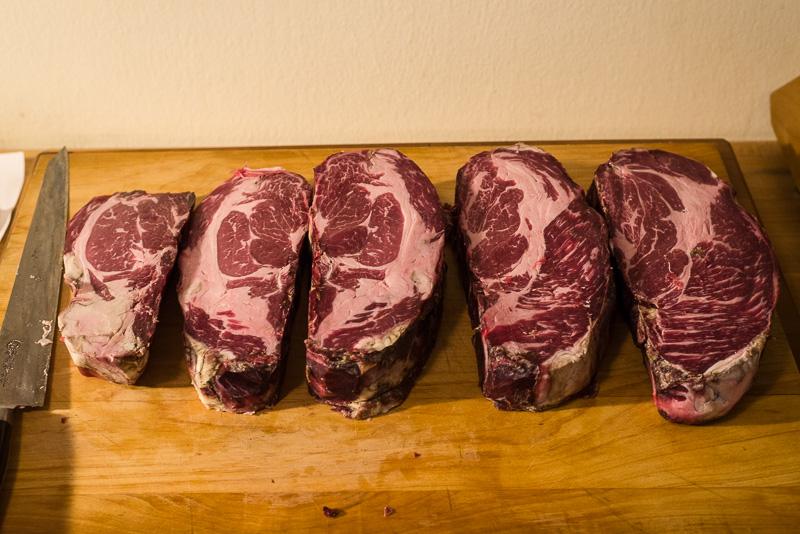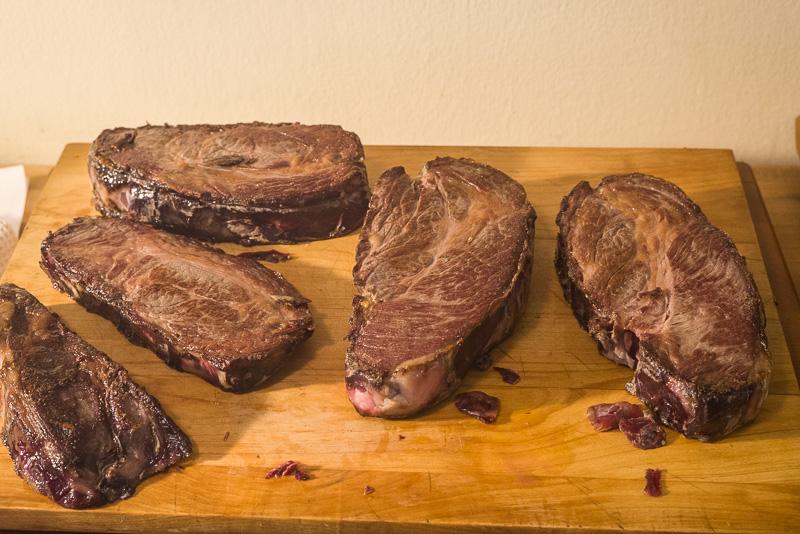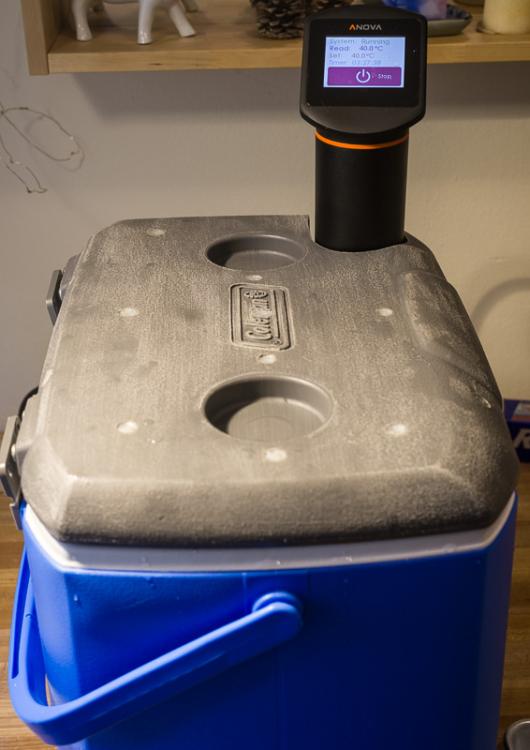-
Posts
5,173 -
Joined
-
Last visited
Content Type
Profiles
Forums
Store
Help Articles
Everything posted by paulraphael
-
In NYC those would be $8/lb steaks at a grocery store. If you compare the marbling to the ones I posted above you can see they're not close. I personally don't think $30/lb is nuts for prime dry aged meat. Mitch and I were spoiled for years by a butcher who sold us $30-40/lb quality meat for around $24. You just could not get meat of that quality anywhere for close to the price. The difference is just ridiculous. Comparing supermarket cryovac steaks doesn't make sense. Believe me, I've had plenty of certified angus. I do not buy it anymore for tender cuts. It makes more sense to me to have steak a third as often but to get the good stuff. Once every couple of months is plenty. The questions get tougher when you look at really expensive meat. I've seen the top end meats from suppliers like DeBragga and Lobell's. Lobell's meat is possibly more marbled than anything else I've seen, but the top grades go for upwards of $70/lb. Is this nuts? I haven't tasted it. I do know it's out of my price range but that's not the same thing. I can't afford a sailboat either ... doesn't mean the asking prices are nuts.
-
And really difficult to regulate the temperature. When a new wood oven pizza place opens in NYC (there have been a lot in the lest several years) it typically takes them a year to get the hang of their oven. Before then the quality is wildly inconsistent. If they were baking cakes it would be worse!
-
The point about the coatings on the eggs being destroyed by cooking is new to me. Is there still any coating left on the eggs after they're washed (as is the practice in the U.S.?) It's been my assumption that pasteurized eggs would last a few months in the fridge—not at the peak of quality or freshness, but that they'd be safe. I haven't seen any studies to back this up.
-
>>do you recall where in MC this was mentioned ? Volume 3, p. 78 >>the rest of a Prime animal has to go somewhere. I assume it goes to restaurants. I've that only about 2% of prime meat in the U.S. gets sold retail. Outside of NYC and the Bay Area it used to be almost impossible to find. It seems like that's a bit less the case these days. >>take a look at an active decent sized meat counter at a regular grocery store. the marbling on the cut meat is not exactly the piece to piece. For sure. The grade goes to the whole side of beef, based on the marbling in just a couple of places. You can sometimes find pieces of choice meat that look more marbled than some prime pieces, even at the same shop.
-
Also, the whole pre-cook thing is of minor compared with what I'm excited about here: the possibility of boutique-quality meat for a quarter the price. The silk purse / sow's ear angle on sous-vide has been around for a while, but I haven't read about people pushing it in this direction ... starting with a really fancy sow's ear, with only adds a little bit to the price. The challenging part for most people will be sourcing the meat. You need to find a butcher with high quality product, and who is willing to age cuts that aren't aren't his usual routine. Or age it yourself, if you get good results doing so. The real idea is that cheap cuts can come from high quality meat, not just from the bargain bin. Even if they cost double what you're used to for that cut, they can be a great value, depending on how you cook them.
-
I don't think I'm playing with fire at all. There's no reason to think this method isn't safe. Tenderizing happens through different processes, and with different textural results. Enzymatic tenderizing is different from thermal tenderizing (which is what we use in traditional cooking to break down collagen, where more heat+time = more tender). I'm also experimenting with the idea that aged flavors can be enhanced with time spent in this temperature range. This is a new idea, and is supported only by research that's designed to answer other questions. I'm playing with the idea right now but haven't done any serious experiments. The one bit of empirical support I have for this (as a tenderizing method) is the short ribs I cooked last week. Other people who have cooked them at 60C for 72 hours have reported some flakiness, but that they had to use a knife. Mine fell off the bone and could be cut with a fork. The meat was medium-rare and had the texture almost of a traditional braise. A lower temperature pre-cook is standard for a lot of chefs. It's a recommended method in the Modernist Cuisine books. My experiments are about the precise temperatures to use. At some point I'll do a more rigorous side-by-side comparison. Right now I'm just trying out the concept. Short ribs were a slam dunk. I'm going to eat one of the steaks tonight and see how it works on a somewhat more tender cut.
-
The idea of a pre-cook at low temperatures is not new. It's been previously recommended to do it in the 45° to 50°C range, because the slightly higher temperatures increase the rate of all processes. The research I've dug up, and some other peoples' empirical evidence, suggest that a lower temperature (40°C) is better for flavor. This is because the enzyme Cathespin is most active at 50°, and can produce off-flavors. And because a few enzymes most responsible for flavor compound development become less active, inactive, above 40C. Please see the post that I linked above. It's generally accepted that the interior of muscle meat is sterile, except in unusual circumstances. This is why it's considered safe to eat traditionally cooked lean meats, which are never cooked to pasteurization. And it's why dry aging for 3 weeks to several months is safe. FWIW, I seared the meat on a griddle. Even with a torch (tedious) I wouldn't trust myself to hit every millimeter of surface. I do the pre-sear for flavor development (in David Arnold and Nils Sorensen's blind tasting of steaks, their favorite results came from combined pre- and post-searing ... I haven't done a side-by-side myself). The simmering water for 60 seconds is about 50% longer than what should be required to pasteurize the surface to a 6D standard (according to modeling in the SV Dash app). I like to add this step for long cooks even if I don't do a low-temperature pre-cook, just because spoilage bacteria are poorly understood. People occasionally get ugly surprises, and I like some insurance. BTW, the pasteurization standard is 6D, not 7D, which still of course means pathogens reduced to .000001 of their original levels (a minute in simmering water probably does better than this—but not as much better as you might think, because of the mass and conductivity of the meat, and the insulating properties of the bag). Charts for e-coli show a doubling in population every half hour at 40C, which means that after 4 hours, you'd be up to .000256 of the original bacterial population, if you'd started with a 6D reduction. This is insignificant. Consider that the meat is then going to spend over 40 hours at a temperature which has a 6D pasteurization time of around 4 hours. One thing I was wrong about: I thought bacterial activity would be higher at 45C or 50C than at 40C. This isn't the case. 40 is pretty close to the peak, at least for e-coli. But this still represents only a doubling every 30 minutes, which doesn't add up to much if the surface is pre-pasteurized.
-
What I'm getting at here isn't the difference between $8 beef and $6 beef. I'm comparing $8 beef to $30 beef.
-
I don't know. The other time I bought a chuck section it was "certified angus" from the supermarket. Probably about $6.50/lb. NYC rent and all that. But it wasn't as marbled as this. I am skeptical that I could match the quality of this aging with anything short of many rounds of trial and error. And possibly not even then. I've worked with a few different butchers who aged meat, and can say for sure that 4 weeks does not equal 4 weeks. A lot goes into determining conditions, and into precise temperature and humidity control, which my refrigerator doesn't offer. I'm sure a dry bag can improve yield but it cannot guarantee quality.
-
It looks a lot like one of their existing lab circulators. Which could explain its quick arrival. I don't know what they changed besides the price (listed at $895 on the lab site).
-
I need to keep it fresh for a solid week, which will include a couple of travel days in a cooler. You're probably right that it will be fine. I just have to be careful, since there's no place to go shopping if I mess anything up.
-
Suppose you want serve some really delicious steak at a dinner party. To a dozen people. On an island, a 12 hour drive and boat ride away. And where the only electricity comes from a solar panel, the stove burns wood, and the propane fridge struggles to maintain 50 degrees. And your budget is $60. Turns out it's nothing a good butcher and cheap immersion circulator can't handle. I had to call around, but finally found a butcher who was excited about the project, and who agreed to dry age a prime chuck roll for me. The man for the job was Rob DelaPietra. He invited me to his eponymous shop in downtown Brooklyn, where we picked a piece of meat together. He cut off a 7.5 lb. hunk from the rib end. Normal price was $10/lb, but since I was buying in bulk he offered it for $8. Expensive compared with regular chuck, but this was a nicely marbled, prime piece of meat. And he was going to charge nothing for the dry aging. My schedule determined that it would age about 4 weeks, which Rob thought would be about right for maximizing flavor with minimal weight loss. Untrimmed Trimmed, but with a bit of funkiness left in place. Final weight is 6.5 lbs. The trim weighed 1/2 lb, so it lost 1/2 lb of water. Seems like very little loss for 4 weeks. All the trim (in another post I'm brainstorming what to with this delicious-smelling stuff) Cut into three 1.75" steaks and two 1.5" steaks. Not as gorgeously marbled as the nicest rib-eyes I've cooked, but still promising. A bit of pre-sear. After this, I bagged the meat and immersed in simmering water for one minute, to kill everything on the exterior. Pre-cooking at 40°C / 104°F for 4 hours, for a final kick to the tenderizing and flavor-producing enzymes (as discussed in this post). It's now finishing off its 48 hours at 55°C. It will be chilled in an ice bath, packed in ice in a cooler, and taken on the road. The wood fire in the kitchen should make searing a snap. A sauce is in progress, not included in the budget. Based on a beef coulis made with pressure-cooked stock and meat jus extracted sous-vide, seasoned with red wine, porcini mushrooms, and thyme. This is just going to be frozen. I'll let you know how it goes. If it's as good as I hope, this may be my new steak paradigm, even for eating at home. I'm really to curious to see how it compares to similarly prepared rib-eye that costs over three times as much.
-
All great ideas. I just want to make sure there's consensus that the stuff is safe. The thing I'm most concerned about is bacterial toxins, which can be chemical and heat-resistant, and fungus / fungus byproducts, which I don't know anything about. Probably far fetched, but I don't want to make a habit of something that might be sketchy. The beef dust idea is intriguing. A vita-prep sounds ideal for the pulverizing (I don't have one, sadly). I wonder if you lose a lot of important aromatics while dehydrating. And ...kinda beside the point, but I wrote that I got a pound of trimmings above. I meant a half pound. Surprisingly little (starting weight was 7.5lbs, so it lost 1/2 lb water also).
-
I suspect it gave its life to save innocent herbs from the cruel and unusual punishment such devices wreak.
-
I don't personally want more than 1kw, but I can see how it would be useful in a commercial kitchen where big, uninsulated cambros are typical. Is there really a history of professional lab circulators with 1.8kw heaters crapping out?
-
I just had a chuck roll dry aged 4 weeks by my butcher (for cutting into steaks that will be cooked sous-vide). When I trimmed off the crust I ended up with about half a pound of really delicious-smelling trim with the texture of jerky. My cat loves it. I'm disinclined to eat it, because I have no idea what kinds of mold and spoilage bacteria are lurking there, but I'm wondering if anyone's experimented with a way to extract flavors or aromas from this stuff? I smell a science project.
-
Just announced today, in case we were suffering a shortage of Anova threads. Looks like they're going for Poly Science's jugular. I'm not sure why the 120v model doesn't got 18KW ... other brands do. Otherwise looks like a killer for $400.
-
Yikes. Do you love North African food? I do, but that would still be a lifetime supply. (one of my favorite lines from the Simpsons ... Marge discovers a costco-style big-box store and is mesmerized. "That's a very good price for 25 pounds of nutmeg!")
-
Does anyone know a well-researched source of information on infusing herb flavors into ice cream? I've figured out some things by trial and error, but there are a lot of variables, and they differ for every herb. Some concerns are -ideal temperatures and times for extracting good flavors but not bad ones (bitter, grassy, indistinct vegetal etc.). If steeping time should be limited or if an herb can remain while the ice cream pasteurizes / the custard sets, etc.) -if there's any way to improve the solvent qualities of milk, like increasing the sugar content to a certain concentration (the sugar syrup component of sorbet is a much stronger solvent than water ... it behaves almost like alcohol. I don't know how much sugar is required to produce this effect in milk, or if the emulsified fat in milk makes a difference) -if it is important to deactivate enzymes (like polyphenoloxidases) with high heat in order to preserve vibrancy of flavors -if putting the herbs with the mix in a blender is bad news -if being cooked with the mix in a sous-vide bag is bad news
-
Any thoughts on the shelf-life of yogurt in a sealed container in a bad fridge? Like around 45-50F?
-
I'm preparing a meal that's going to be served on an island in Maine, where facilities are limited to a wood-burning stove and a propane-powered fridge. I'm preparing a lot of food in advance, either sous-vide or frozen. One idea is a cucumber gazpacho that I'd like to freeze. It's a simple recipe with cucumbers, shallots, garlic, herbs, yogurt, and olive oil. Everything's pureed (the original idea includes smoked salmon, which I'm not including this time. I based the soup on an awesome version at café Boulud years ago). Is it true that I could have issues with the yogurt developing grainy textures when it's frozen and thawed? Is this from the emulsion breaking? Synerisis? Anything that can be done about it? I'm wondering if anything like xanthan gum in very small quantities could help hold it together.
-
These Coleman "xtreme" coolers have insulated lids. I'd have gotten one if I'd known about them. A lot cheaper and easier than my questionable project of insulating the lid with foam. Some people have questioned the value of the lid insulation, but I'm betting it's worth at least a little. I also use reflectix.
-
I've never used my silpat in the oven. people do, when they need better release than parchment (or a bit more insulation), but the silicone is especially useful for working with tuilles and hardened sugar syrup and other things that would stick like glue if they dried on regular surfaces.
-
I cut my sil-pat in half (so it would fit on two half-sheet pans). They tell you not to, but I don't know why. It's fine.
-
I was wondering about this. I looked up my cooler on the Coleman site. All it says is "insulated case for longer ice retention." It does not say "insulated lid," and indeed the lid had nothing in it. Some of their other coolers are fancier, and the site goes into more detail about what's in there. I don't feel quite curious enough to drill a hole and take a look.




